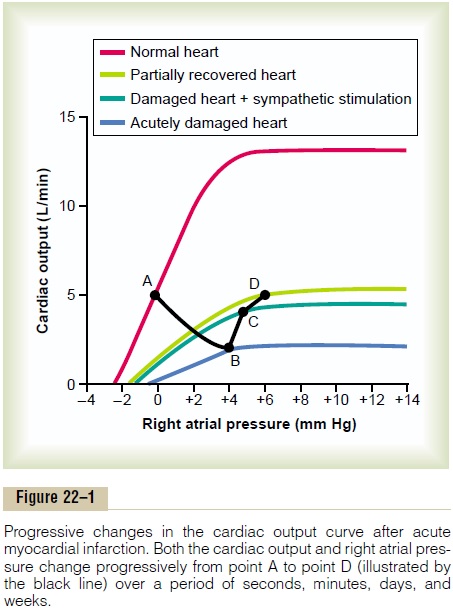Chapter: Medical Physiology: Cardiac Failure
Summary of the Changes That Occur After Acute Cardiac Failure- ÔÇťCompensated Heart FailureÔÇŁ
Summary of the Changes That Occur After Acute Cardiac Failure- ÔÇťCompensated Heart FailureÔÇŁ
To summarize the events discussed in the past few sec-tions describing the dynamics of circulatory changes after an acute, moderate heart attack, we can divide the stages into (1) the instantaneous effect of the cardiac damage; (2) compensation by the sympathetic nervous system, which occurs mainly within the first 30 seconds to 1 minute; and (3) chronic compensations resulting from partial heart recovery and renal reten-tion of fluid. All these changes are shown graphically by the black curve in Figure 22ÔÇô1. The progression of this curve shows the normal state of the circulation (point A), the state a few seconds after the heart attack but before sympathetic reflexes have occurred (point B), the rise in cardiac output toward normal caused by sympathetic stimulation (point C), and final return of the cardiac output almost exactly to normal after several days to several weeks of partial cardiac recov-ery and fluid retention (point D). This final state is called compensated heart failure.
Compensated Heart Failure. Note especially in Figure22ÔÇô1 that the maximum pumping ability of the partly recovered heart, as depicted by the plateau level of the light green curve, is still depressed to less than one-half normal. This demonstrates that an increase in right atrial pressure can maintain the cardiac output at a normal level despite continued weakness of the heart. Thus many people, especially older people, have normal resting cardiac outputs but mildly to moder-ately elevated right atrial pressures because of various degrees of ÔÇťcompensated heart failure.ÔÇŁ These persons may not know that they have cardiac damage because the damage often has occurred a little at a time, and the compensation has occurred concurrently with the progressive stages of damage.

When a person is in compensated heart failure, any attempt to perform heavy exercise usually causes immediate return of the symptoms of acute failure because the heart is not able to increase its pumping capacity to the levels required for the exercise. There-fore, it is said that the cardiac reserve is reduced in compensated heart failure.
Related Topics